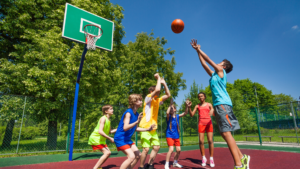The design and flow of a sporting facility play a crucial role in its overall success, impacting everything from spectator satisfaction to athlete performance and revenue generation. Whether you’re building a new facility or upgrading an existing one, understanding the key elements of design can help you create a space that meets the needs of all users. Here’s why design and flow are so important in sporting facilities:
1. Spectator Experience: Efficient design ensures smooth crowd movement, reducing congestion and enhancing the overall experience for fans. Thoughtful placement of entry points, seating arrangements, and amenities like restrooms and concessions can make a significant difference in how spectators perceive and enjoy an event. A well-designed facility allows fans to move easily through the venue, minimizing frustration and maximizing enjoyment.
2. Athlete Performance: The design of a facility directly impacts athlete performance. Providing optimal conditions, such as proper warm-up areas, seamless transitions between spaces, and easy access to necessary amenities, helps athletes focus on their performance without unnecessary distractions. A well-thought-out layout can also reduce the risk of injury by ensuring that athletes have the space they need to prepare and compete safely.
3. Safety and Security: Safety is a paramount concern in sporting facilities, especially when managing large crowds. A carefully designed venue allows for efficient crowd control, quick evacuations if necessary, and secure areas for athletes, VIPs, and staff. Incorporating safety features into the design, such as clearly marked exits, secure entry points, and controlled access zones, helps ensure that both spectators and participants feel safe at all times.
4. Broadcast and Media Considerations: In today’s media-driven world, sporting facilities must accommodate complex broadcasting equipment and provide suitable spaces for media operations. This includes ensuring that camera angles, lighting, and sound systems are all optimized for live broadcasts and recordings. Adequate space for media personnel, along with reliable access to power and communication networks, is essential for seamless coverage of events.
5. Flexibility: Many sporting venues are multi-purpose, hosting a variety of events beyond just sports, such as concerts, conferences, and community gatherings. Flexibility in design allows these spaces to be reconfigured efficiently to accommodate different types of events. Movable seating, modular stages, and adaptable lighting systems are just a few examples of design elements that can enhance the versatility of a facility.
6. Sustainability: Sustainable design is increasingly important in the construction and operation of sporting facilities. Thoughtful design choices, such as energy-efficient lighting, water-saving fixtures, and sustainable building materials, can significantly reduce a facility’s environmental impact. Implementing green technologies not only supports environmental goals but can also lead to cost savings over time.
7. Revenue Generation: The strategic placement of concessions, merchandise stands, and premium areas can significantly enhance revenue potential. By designing spaces that encourage spending, such as conveniently located kiosks or exclusive VIP areas, facilities can increase their profitability. The flow of foot traffic should be considered to ensure that high-traffic areas maximize sales opportunities without causing congestion.
8. Accessibility: Ensuring easy access for all spectators, including those with disabilities, is a critical aspect of modern venue design. This includes providing ramps, elevators, and seating that accommodate wheelchairs, as well as clear signage and assistance services for those who need them. A commitment to accessibility not only meets legal requirements but also ensures that the venue is welcoming to everyone.
Why Experience Matters: Firms like TBPM, with over 25 years of experience in sports facility design, bring invaluable insights into the unique challenges and requirements of these spaces. Their expertise ensures that every aspect of design and flow is considered, from enhancing spectator experiences to ensuring the safety and security of all users.
Ready to design a sports facility that excels in every aspect?
Contact TBPM today to leverage our decades of experience and create a venue that meets the highest standards of design, safety, and functionality. Let’s build a space that stands out!
AI-Assisted Content Disclaimer
This article was created with AI assistance and reviewed by a human for accuracy and clarity.











